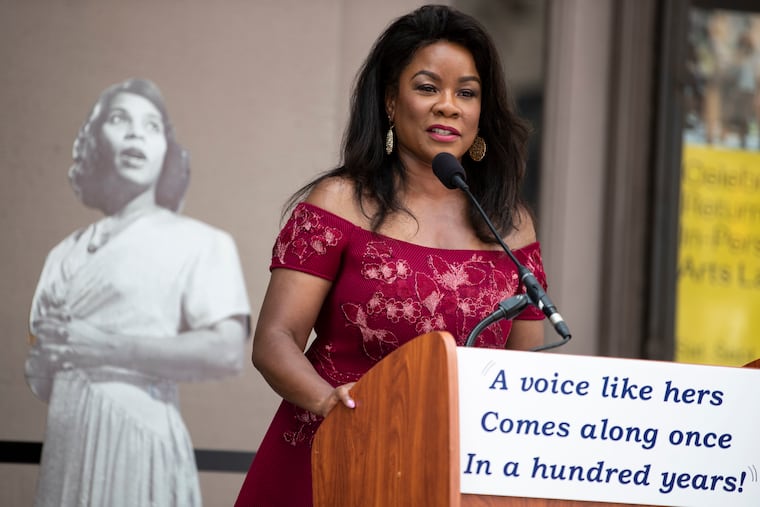City leaders make it official: Marian Anderson will be honored with a sculpture on S. Broad Street
The sculpture will be sited outside of the Academy of Music, and the fund-drive to pay for the project is moving apace.

Mayor Kenney, opera star Denyce Graves, and dozens of city leaders gathered at the steps of the Academy of Music Thursday to spark support for a sculpture honoring beloved singer and civil rights figure Marian Anderson.
About $300,000 has been raised toward the $1.4 million campaign, whose proceeds would pay for the sculpture and related expenses, as well as the beginning of an endowment for the Marian Anderson house museum in South Philadelphia devoted to the contralto’s legacy.
The piece is to be placed on or near the front steps of the Academy of Music, officials announced, where Anderson performed several high-profile recitals.
“In addition to her fame and prominence as a singer, Marian Anderson should be remembered and celebrated for how she met racism with grace and indignity with dignity,” said Kenney, telling the crowd gathered at Broad and Locusts Streets that the sculpture would be the “first free-standing statue depicting a historic Black female figure in Philadelphia’s history.”
Anderson, born in Philadelphia, died in 1993 at age 96. She is revered for a triumphant 1939 concert at the Lincoln Memorial organized after she was denied an opportunity to sing at Constitution Hall in Washington because of her race. Although more of a recitalist than an opera singer, she was the first Black artist to sing a leading role with the Metropolitan Opera.
“Please don’t think for a moment that this honor for Marian Anderson is a local consideration. It is not,” said Graves, who added that she would support the effort and encouraged others to do so. “Miss Anderson impacts American history, the classical vocal arts, and Philadelphia, for sure. But this is a story of the United States of America and the world.”
The sculpture project — talked about generally for years, and spurred most recently by a Nov. 14 Inquirer column cited by officials on Thursday as the impetus — is still in its initial stages. A task force has been raising the money, and a jury is expected to develop a set of parameters to help choose the artist. The project will consult with representatives from the Pennsylvania Academy of the Fine Arts, Moore College of Art and Design, the Barnes Foundation, and the University of the Arts, as well as neighborhood groups, on design ideas and potential artists.
The task force expects to announce a design by Feb. 27, the 125th anniversary of Anderson’s birth.
Various speakers on Thursday discussed the singer’s musical significance, her pivotal role in the struggle for civil rights, and how the city should take greater ownership of her story. Jillian Patricia Pirtle, CEO of the Marian Anderson Historical Society and Museum, spoke about her wish that the sculpture “meet the moment” and become a link to the house museum that is the “heartbeat” of the singer’s legacy.
Kenney cast the importance of a Marian Anderson sculpture as something of even greater significance.
“On a personal note, who the city visibly commemorates is important to me,” the mayor told the assembled dignitaries, “which is why I think, given the incredible contributions from people of color to Philadelphia throughout our history, more statues like this are needed to tell the true and accurate story of Philadelphia in America’s history, which has not been told for hundreds of years. It is time to tell that story now.”
Donors wishing to give money to the Marian Anderson sculpture project may do so via the Philadelphia Foundation at philafound.org.